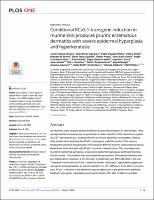Please use this identifier to cite or link to this item:
https://repositorio.usj.es/handle/123456789/382
| Title: | Conditional KCa3.1-transgene induction in murine skin produces pruritic eczematous dermatitis with severe epidermal hyperplasia and hyperkeratosis |
| Authors: | Lozano-Gerona, Javier


Olivan-Viguera, Aida 

Delgado-Wicke, Pablo 

Singh, Vikrant 
Brown, Brandon M. 

Tapia-Casellas, Elena 
Pueyo, Esther 


Valero Gracia, Marta Sofía 


García-Otín, Ángel Luis 


Giraldo, Pilar 


Abarca-Lachén, Edgar 


Surra, Joaquín Carlos E. 

Osada, Jesús 

Hamilton, Kirk L 
Raychaudhuri, Siba Prasad 
Marigil, Miguel Angel 
Juarranz, Ángeles 

Wulff, Heike 

Miura, Hiroto 
Gilaberte, Yolanda 


Köhler, Ralf 

|
| Keywords: | Dermatitis; KCa3.1 |
| Issue Date: | 9-Mar-2020 |
| Publisher: | Public Library of Science |
| Citation: | Lozano-Gerona J, Oliván-Viguera A, Delgado-Wicke P, Singh V, Brown BM, Tapia-Casellas E, et al. (2020) Conditional KCa3.1-transgene induction in murine skin produces pruritic eczematous dermatitis with severe epidermal hyperplasia and hyperkeratosis. PLoS ONE 15(3): e0222619. https://doi.org/10.1371/journal.pone.0222619 |
| Description: | Ion channels have recently attracted attention as potential mediators of skin disease. Here, we explored the consequences of genetically encoded induction of the cell volume-regulating Ca2+-activated KCa3.1 channel (Kcnn4) for murine epidermal homeostasis. Doxycycline-treated mice harboring the KCa3.1+-transgene under the control of the reverse tetracycline-sensitive transactivator (rtTA) showed 800-fold channel overexpression above basal levels in the skin and solid KCa3.1-currents in keratinocytes. This overexpression resulted in epidermal spongiosis, progressive epidermal hyperplasia and hyperkeratosis, itch and ulcers. The condition was accompanied by production of the pro-proliferative and pro-inflammatory cytokines, IL-β1 (60-fold), IL-6 (33-fold), and TNFα (26-fold) in the skin. Treatment of mice with the KCa3.1-selective blocker, Senicapoc, significantly suppressed spongiosis and hyperplasia, as well as induction of IL-β1 (-88%) and IL-6 (-90%). In conclusion, KCa3.1-induction in the epidermis caused expression of pro-proliferative cytokines leading to spongiosis, hyperplasia and hyperkeratosis. This skin condition resembles pathological features of eczematous dermatitis and identifies KCa3.1 as a regulator of epidermal homeostasis and spongiosis, and as a potential therapeutic target. |
| URI: | https://repositorio.usj.es/handle/123456789/382 |
| ISSN: | 1932-6203 |
| Appears in Collections: | Artículos de revistas |
Files in This Item:
| File | Description | Size | Format | |
|---|---|---|---|---|
| Conditional KCa3.1-transgene induction in murine skin produces pruritic eczematous dermatitis with severe epidermal hyperplasia and hyperkeratosis.pdf | 3,33 MB | Adobe PDF |  View/Open |
This item is licensed under a Creative Commons License

